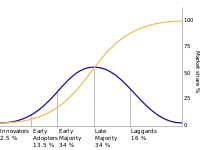
Photo from wikipedia
Biofilms are multicellular communities with a spatial structure. Different from single-cell scale diffusion in planktonic systems, the diffusion distance becomes the dimension of multicellular clusters in a biofilm. Such differences… Click to show full abstract
Biofilms are multicellular communities with a spatial structure. Different from single-cell scale diffusion in planktonic systems, the diffusion distance becomes the dimension of multicellular clusters in a biofilm. Such differences in diffusion behavior affect the tolerance and response to exogenous stress. Here, we found that at the same doses of exogenous hydrogen peroxide (H2O2), planktonic Escherichia coli were completely killed within two hours, whereas the biofilm resumed growth in six hours by building a catalase barrier to block H2O2 penetration, despite the growth burden. Unexpectedly, when we changed the carbon source from glucose to glycerol, H2O2 instantly counterintuitively boosted biofilm growth due to supplemental oxygen, which was the growth-limiting factor. We further demonstrated that the energy metabolism modes determined the growth-limiting factor, which then determined the two patterns of biofilms resistances to H2O2.
Journal Title: Science advances
Year Published: 2023
Link to full text (if available)
Share on Social Media: Sign Up to like & get
recommendations!